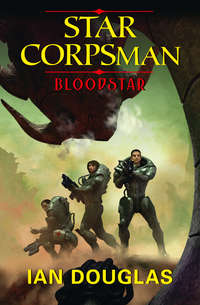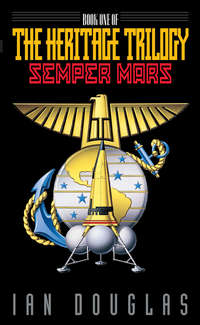
Полная версия
Star Marines



For Brea, who saw me through the worst of times
Table of Contents
Title Page
Dedication
“They’ve Found the Intruder, Sir.”
Prologue
Chapter 1
Chapter 2
Chapter 3
Chapter 4
Chapter 5
Chapter 6
Chapter 7
Chapter 8
Chapter 9
Chapter 10
Chapter 11
Chapter 12
Chapter 13
Chapter 14
Chapter 15
Chapter 16
Chapter 17
Chapter 18
Interlude
Chapter 19
Chapter 20
Chapter 21
Chapter 22
Chapter 23
Chapter 24
Epilogue
Books in the Legacy Trilogy by Ian Douglas
Copyright
About the Publisher
“They’ve found the intruder, sir.”
“Let me see.”
A three-dimensional schematic opened in a new mental window. The intruder’s course was clearly marked, as were the last known positions of the monitor Prometheus and the patrol frigate Rasmusson, several High Guard drones, and Mars. A tiny white star had detached from the crimson star marking the intruder. “What’s that?”
Data unfolded in columns down the right side of the window. “Mass analyses suggests it’s a small asteroid, sir,” Bettisly told him. “About one kilometer across … mass approximately two billion tons. The intruder seems to have nudged it onto a new vector.”
Garroway studied the data with growing horror. “Two thousand kilometers per second?”
“Yes sir.”
“That’s a hell of a nudge.” A cold thought gripped his heart. “Where’s it going? What’s the target?”
The schematic shrank in the window, showing more of the orbit of Mars … and then of Earth. A yellow line projected itself along the rock’s projected path, which passed just in front of Earth’s current position. The white star tracked down the slightly curving line as Earth moved forward …
“Great Father in Heaven …”
Prologue
They were called the Hunters of the Dawn.
Their own name for themselves did not translate well into the languages of lesser beings. It might have been rendered, very approximately, as “the Sentient Ones,” or even, more approximately, as “Living Ones,” or simply as “We Who Are.”
All who were not We Who Are were lesser life forms, scarcely worthy of notice save when they became threats. When that happened, they became prey.
The name Hunters of the Dawn had been applied to them by others long ago, members of an interstellar cooperative now long extinct. More recently—several thousand years before, another species had named them Xul … a word that translated, again approximately, as “Demons.”
What other species called them, or thought of them, scarcely mattered. The Ones Who Are obeyed Darwinian dictates hard-wired into the genome of their distant ancestors a billion years in the past, dictates that drove them to seek out and eliminate any civilization capable of posing a threat to their eons-long dominion over the Galaxy.
Lately, a star system at the edge of a minor branching on one of the galactic spiral arms had become of particular interest to We Who Are. A signal from a Living Ones Seekership long believed lost had been received, indicating that intelligence once again had developed space-faring technology in Sector 2420. More recently, a Huntership had taken samples from a primitive interstellar vessel at the Gateway designated 2420-001, confirming the re-emergence—and the technological evolution—of an organic species texted as Species 2824.
And not long after that, the Huntership had been tracked through the Gateway—presumably by those same intelligences—and destroyed.
This was not to be tolerated, could not be tolerated, without violating the genetic coding that formed the social dynamic of We Who Are.
The ancient records had been consulted. The system designated 2420-544 had been of interest at least twice before in the past three hundred thousand cycles, and there were indications of contact and annihilation within that star system even farther back than that. The Lords Who Are had consulted together, drawn their conclusions, and generated their plans.
A Huntership had been dispatched.
That vessel emerged now from paraspace, six light-hours from the target primary. That primary, a bright star only at this distance, was a fairly typical yellow sun possessing a number of planets. Samplings of the electromagnetic spectrum revealed a cloud of structures, vessels, and transmitting objects swarming about the inner system. Most were clustered around one particular planet—third from the sun, blue with liquid water, the spectra rich with the absorption lines of chlorophyll, and humming with the electronic signature of technic life.
The system matched—within a probability of ninety-plus percent—the system described by the creatures taken at Gateway 2420-001 a hundred cycles ago. Dissected, patterned, and absorbed, those creatures had yielded a wealth of information about their nascent civilization and origins. That Gateway, about eight light-years distant from this system, was called Sirius in the language of these creatures.
Species 2824 called this star system Sol … and their homeworld, the third planet, Earth.
The Lords Who Are within the Huntership examined the data, and reached consensus.
Species 2824 posed a threat to We Who Are.
This species, therefore, would die.
Ponderously, and with cool and unemotional deliberation, the Huntership began moving sunward.
1
12 FEBRUARY 2314
Assault Detachment Alpha
Above Olympus Mons,
Mars
1235 hrs, local
He was sealed inside a windowless carbotitanium laminate alloy canister so tiny there was scarcely room to breathe, much less move, but his noumenlink gave him a complete three-sixty on the view outside.
Gunnery Sergeant Travis Garroway, USMC, was streaking through thin atmosphere, hitting it hard enough to scratch a searing contrail of ionized gas across the night-black sky. His entry pod was surrounded by a faint haze of plasma, but he could still see the surface of Mars spread out beneath him like a map—all ochers and tans and rust-reds, desert colors achingly reminiscent of the American Southwest back home.
Ahead, Olympus Mons rose against the curve of the Martian horizon, enormous, stunning in its size and sweep and grandeur. The crest of Olympus Mons reached twenty-seven kilometers above the Martian desert floor—three times the height of Everest above sea level. As big as the state of Missouri, it was the largest volcano in the Solar System.
Garroway had stood at the base of that mountain three months earlier, playing tourist, and hoping to get a look at it from ground level. The results, however, had been disappointing. Olympus Mons was so large that the curve of the Martian horizon actually hid the peak from an observer standing at the mountain’s base. The only way to see, to really feel the size of that monster shield volcano was to see it from orbit, or … as Garroway was doing now, on a hot-trajectory re-entry forty kilometers up.
“Alpha Two, Alpha Three,” he called. “Do you copy? Over.”
Static hissed in his earphones.
“Alpha Two, Alpha Three. Chrome, are you hearing me?”
Still nothing. The re-entry ionization was still too heavy to permit radio communications. Damn. He’d wanted to share this with Chrome—Staff Sergeant Angelina O’Meara.
A jolt caught the entry capsule, punching the breath from his lungs and eliciting a sharp, bitten-off curse. There was a popular misconception going the rounds at Eos Chasma, the Martian equivalent of an urban legend, to the effect that Olympus Mons was so tall the crest actually extended above the Martian atmosphere. He wished the idiots spreading that nonsense were with him now, enjoying the ride. The average surface pressure on Mars was only about one percent of Earth-normal, and at the top of Olympus Mons, the pressure dropped to two percent of that.
By contrast, the atmospheric pressure at the top of Mt. Everest was about twenty-five percent of the pressure at sea level; the Martian atmosphere was thin—the next best thing to hard vacuum, as Captain Fetterman liked to say—but the one-third gravity meant that it didn’t get squeezed down as tightly to the surface as on Earth, but extended much farther into space. There was plenty of—thud!—atmosphere here two miles above the mountain’s caldera-cloven crest to give him a hell of a ride.
Mars Military Training Command
Stickney Base,
Phobos
1236 hrs, local
Colonel Robert Ellsworth Lee lay in a couch on the Mars Observation Deck, watching the show. In reality, the tiny, inner Martian moon was currently above Elysium, over the horizon from Olympus Mons, but his noumenal link relayed the imagery from a low-altitude robotic satellite positioned to track Alpha’s atmospheric entry and descent.
From this vantage point, unfolding within the window of his mind, the orange face of Mars, pitted and wrinkled, stretched across the entire black reach of the sky. A cloud of brilliant stars streaked across that face, trailing white fire.
Thirty-two of those stars were the IMACs of the Alpha drop. The rest were decoys, deployed to shield the insertion from enemy radar and laser sensors. IMAC—the acronym was pronounced “eye-mac”—stood for Individual Marine Assault Craft, a name that seemed a bit grandiloquent for something not much bigger than a large garbage can.
Ever since World War II, some 370 years before, the Marine Corps had searched for new and effective ways to deliver combat Marines to the beachhead. On an island atoll called Tarawa, in 1943, thousands of Marines had died because their landing craft had grounded on a reef well off an enemy-held beach, forcing the men to wade or swim ashore under devastating machine-gun, mortar, and artillery fire. That near-disaster had resulted in the introduction of the Marine amphibious vehicle—the AMTRACK—and, in later years, a whole zoo of armored amphibious vehicles designed to swim Marines ashore and provide them with firepower once they got there. Other innovations had included the helicopter, the tilt-rotor Osprey, and the high-speed hovercraft.
As their battlefields began extending into the vastness of space and to the surfaces of alien worlds, those delivery systems had become more and more powerful, more and more complex. The AMTRACKs, LCACs, LVTPs, and AAVs of the twentieth century had given way to various types of planetary landing and assault boats, combat shuttles, and boarding pods. IMACs were only the latest twist, derivations of the standard ship-to-ship boarding pods in use for the past century or so.
A boarding pod or an assault boat, however, had one key weakness. It had to get from here to there through enemy point-defense fire, but with the knowledge that one hit would take out the craft and every Marine packed on board—perhaps as many as fifty or more on some of the larger shuttles.
The key to survival in modern combat was dispersal. Don’t provide the enemy with a few large targets, each carrying many Marines. Instead, let each Marine have his own landing craft—many, many small targets, each with one Marine sealed into a tiny, high-tech cocoon. High-energy lasers and missiles with antimatter warheads were going to score a kill if they hit the target, no matter what. Better, then, that each warhead that struck home killed one Marine rather than fifty.
Besides, for each one-man pod in flight, there might be a dozen or more decoys which, together with the high-energy electronic jamming going on, was guaranteed to give radar technicians, airspace monitor AIs, and tracking networks complete and utter breakdowns of one kind or another.
Colonel Lee was intensely interested in this new application of LZ-acquisition technology, as the current milspeak phrased the concept. He was CO-1MarReg, the commanding officer of the 1st Regment of the 3rd Marine Division, and he’d been tasked with transforming that unit into something new—a Marine Recon Strike Team, or RST.
Or … perhaps the concept wasn’t that new after all. In an earlier era, with simpler technologies, the Regimental Landing Team had been the ground element of a Marine Expeditionary Brigade. Over the past two centuries, as the Corps had added interstellar operations to its collective repertoire, the primary measure of force deployment had been the Marine Interstellar Expeditionary Unit (MIEU), which numbered about a thousand to twelve-hundred personnel, and which could be deployed, with all its gear and supplies, on board a couple of fleet transports.
The RST numbered only eight hundred men and women, the size of two traditional battalions, but it included a recon battalion, a special weapons battalion, an attached air element of sixteen aerospace fighters, plus a headquarters constellation. Smaller meant faster, more flexible, and more maneuverable, or, at least that was the idea. An RST could be dropped onto a hostile planet to reconnoiter ahead of an MIEU landing, or provide troop backup for the Navy’s High Guard in the Outer System. These new IMACs would increase a landing team’s chances of surviving an insertion onto a hostile planet under fire, or serve as boarding pods in ship-to-ship actions. If the new Oannan/N’mah technology worked as advertised, it would mean a whole new era in interstellar Marine force-projection. If it didn’t …
Well, Lee wasn’t going to look that far ahead, not yet. Thirty-two good men and women were riding that tech now, and their lives depended on it functioning perfectly.
He sensed other presences in the noumen around him—Major Bishop of Second Battalion, and Captain Fetterman of Bravo Company. Those were their men and women down there, too. There were some higher-ranking officers present as well. Rear Admiral Kenneth Jollett, who was in charge of the Penetrator program; Brigadier General Hudson, an Army officer assigned to the training center as a Congressional liaison; and Major General Hernandez, CO of the MMTC facility on Phobos.
And, of course, Brigadier General Clinton Vincent Garroway, CO of 1MIEU. Strictly speaking, the IMAC test didn’t directly concern his command, but there was no way he wasn’t going to be present, not with his nephew riding one of those hot tin cans down from orbit. Keeping him clear of the Phobos observation deck would have required a direct order from the Commandant … backed up by nothing less than the battlecruisers and carrier squadrons of Fifth Fleet.
Sometimes it seemed tougher watching from the rear. …
“When will we be able to get direct data again?” Hudson asked over the noumenal link. “I don’t like being in the dark up this way.”
“According to the predicted track … another thirty seconds or so,” Jollet told him. “Then we’ll have all the data we can slurp.”
“Assuming they make it through,” Hudson said.
“Don’t even think it, Walter,” Garroway growled over the link. “They’ll make it!”
“I just don’t like this reliance on alien technology,” Hudson said. “We should have developed it on our own.”
“Beggars,” Jollett told him, “can’t be choosers.”
“Well, it does look like everything’s going smoothly,” Hudson said.
“I imagine the Marines sealed inside those cans would have something to say about that,” Lee replied, wryly amused. “According to the predicted flight track data, they’re at the point of maximum turbulence in their descent. I imagine things are a bit wild, right now.”
“Roger that,” General Garroway added. “Damn, I wish I was down there with them!”
“They can handle it, General,” Admiral Jollett said.
“Damn right they can handle it, Admiral. They’re Marines.”
Lee felt the pride in the older man’s mental voice, but couldn’t detect any fear. He knew the general was close to his nephew; he honestly didn’t know how the man was handling the stress of … just watching, watching as his nephew fireballed into atmosphere at five klicks per second.
Like General Garroway, Lee’s single biggest regret was that his request to accompany the team had been unceremoniously rejected. He was a firm believer in leading from the front.
Assault Detachment Alpha
Above Olympus Mons,
Mars
1236 hrs, local
His noumenal HUD showed him the probable locations of each of the other fifteen IMACs in Alpha Section. Probable location meant just that. For the duration of the communications blackout incurred during re-entry, transponder signals were scrambled and the datalink connecting the Marines with one another and with headquarters wasn’t much more than wishful thinking. His battlesuit’s AI was taking an educated guess on the current positions of the other IMACs, based on the last recorded vector of each, and plotting them on the display imagery unfolding within his mind.
Directly below, the caldera of Olympus Mons opened like a gaping mouth—an oval eighty-five kilometers long, sixty wide, and a sheer-sided three kilometers deep. Six overlapping pit craters pocked the yawning caldera; he could see a trace of snow in the shadows. The atmospheric pressure there was too low to permit water vapor to freeze out; those white streaks must be frozen carbon dioxide.
And then the mountain was falling away behind him, the vast swelling of the mountain dropping faster than the IMAC’s descent. At his mental request, data cascaded through his noumen. Altitude now thirty-two kilometers, dropping at three hundred meters per second, velocity four point one kilometers per second. A bubble of superheated plasma was forming around him—not thick enough yet to block visibility, but fiery enough to create the illusion of blowtorch flames billowing past him.
His heart was pounding, his mouth dry. He felt like he was getting hotter, and sternly told himself it was his overactive imagination. He’d worked with IMACs endlessly in simulation, both on Earth, and ever since he’d arrived at the Marine Corps Deep Space Training Facility at Eos Chasma. But this was his first time in one for real, his first time stuffed into a shit-can and fired out of a Marine Stealth Starfire in planetary orbit.
Another thud, a hard one, and his AI feed reported chunks of ablative falling away. From his vantage point, it looked as though he’d just loosed a salvo of flares through the fireball. He had to remind himself that that was what was supposed to happen. As the ceramic ablative material broke free of the IMAC, it helped shed some of the fierce heat building up outside, scant centimeters from his battle-armored body, and also added to the confusion of ground-based sensors and AIs.
But it was difficult to avoid the disconcerting thought that he was flying in a conventional spacecraft, and that pieces were breaking off and falling away.
Altitude twenty-five thousand meters, a voice told him in his mind. Deploy air brakes and aeroform surfaces, yes, no?
“Negative on air brakes and aeroform,” he told the AI in his head. “We’ll deploy at twelve thousand meters, with HALO deployment as automated backup.”
In other words, if something nasty happened and he was rendered unconscious or worse by high G-forces in the next few moments, the AI would still bring him safely to the surface. Or what was left of him, at any rate. The important thing was that the data from his suit be retrieved.
Very well. Backup HALO deployment confirmed. I will reconfirm at seven thousand meters.
“Nag,” he told it. There was no response. The suit AI was rather limited in its conversational abilities, or, indeed, for any thought beyond an extremely narrow purview.
Ahead, he could see three more shield volcanoes stretched across the horizon in orderly procession. Similar to Olympus Mons, but far smaller, they were, with their huge cousin, part of the ancient Tharsus Bulge, a static region of volcanic activity where magma deep beneath the planet’s surface crust had upwelled into the crust perhaps a billion years ago. From north to south they were Ascraeus Mons, Pavonis Mons, and Arsai Mons. The central mountain, he recalled, was perched almost precisely on the Martian equator. His descent would carry him above Ascraeus Mons, on the left.
Garroway gave his flight system indicators another mental glance. Everything was tracking as expected. Decoys maintained their position in a loose cloud around and ahead of him, each leaving its own meteor-trail of ionized gas.
Ascraeus Mons slid gently past below, followed moments later by the vast and tangled patchwork of rills and canyons dubbed Noctis Labyrinthus, the Labyrinth of Night. Strike Force Sierra One-one burned through the dark Martian sky.
Operation Skyfire. It was a training exercise—only a training exercise, though that didn’t mean Garroway and his fellow Marines were guaranteed a ride back to base and a hot shower when they got there. Marines trained constantly, honing skills against the day when they would be needed for actual combat. Two millennia before, the Jewish writer Josephus had observed of the Roman legions that their exercises were bloodless battles, their battles bloody exercises, and that could accurately be said of the modern U.S. Marine Corps as well … except for the fact that even training exercises could turn bloody in a single unguarded instant.
Today, a total of thirty-two Marines of Bravo Company, of the 3rd MarDiv’s 2/1, were training with the newly commissioned IMAC combat-insertion pods, launched from one of the equally new S/R F-8 Starfire deep-recon spacecraft. The mission objective was to enter the Martian atmosphere and deploy in a simulated planetary surface strike. Their intended LZ was a stretch of ancient watercourse terrain at the far end of the Vallis Marineris called Eos Chasma, not far from the Eos USMC Deep Space Training Facility.
Excitement in Bravo Company was running at damned close to lightspeed. This was the first time the IMACs had been employed outside of simulation and with human Marines—as opposed to test pilots or robotic AIs—strapped inside. Everything was going well so far, but so much was still in the hands of the Laughing Dark God, Murphy.
A very great deal could still go horribly wrong.
Beyond the Noctis Labyrinthus, the terrain split to north and south, then yawned open in the titanic chasm called the Vallis Marineris—the Valley of the Mariner Spacecraft, named for the robot that had first imaged the canyon three and a half centuries before.
If Olympus Mons was the largest volcano in the Solar System, Vallis Marineris was the largest valley—three thousand kilometers long, in places six hundred kilometers wide and as much as eight kilometers deep. The Grand Canyon on Earth could have fit comfortably in one of Marineris’s tributary valleys.









